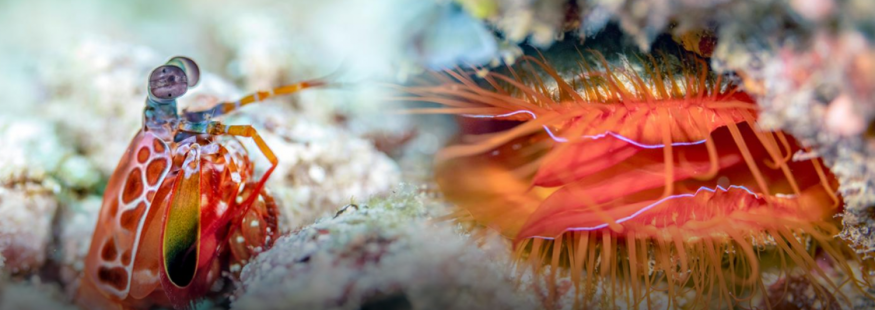
Last week, the Internet was amused by a video of mantis shrimp circulating online. The mantis shrimp is known for being a boxer under the sea -- and an astounding one, at that -- using its hammer-like limbs to smash its prey with such ferocity that can cut claws off crabs and cracks clamshells effortlessly.
This time, instead of its usual prey, the mantis shrimp trended online for trying to one-up its opponent. The opponent? The newly discovered disco clam.
OVERVIEW OF THE MANTIS SHRIMP AND THE DISCO CLAM
Despite being called a shrimp, the mantis shrimp is anything but. Mantis shrimp belongs to a group of arthropods that are a distant relative to crabs, shrimps, and lobsters. Their distinct characteristic will be the presence of club-like appendages, which are called dactyls, and are primarily used to pounce on their prey. These appendages are no joke: it can spring from a mantis shrimp's body at 50 miles per hour, that's quicker than the acceleration of a .22-caliber bullet so that when they hit their prey, they deliver 160 pounds of force.
There are 550 species of mantis shrimp in the oceans and can be classified by the way they target their prey -- by smashing or spearing. Mantis shrimps which have spears for appendages use these in a similar way humans use a harpoon gun.
On the other hand, the disco clam is not as aggressive. The disco clam was discovered by Dr. Lindsey Dougherty back in 2011 as an undergraduate student at the University of Colorado Boulder and was able to visit North Sulawesi in Indonesia for a research trip. What caught Dr. Lindsey Dougherty's attention was the disco clam's ability to showcase vivid colors.
The disco clam showcases its bright-red appendages that extend out of their shells, and thin strips of tissue within its body reflect with sparkly light. This gave an impression of a disco ball. The reflection of light captured Dr. Lindsey Dougherty's curiosity. She remembers thinking about how those bivalves flash.
Clams carry tiny silica spheres in their tissue, which allowed the pulsing of sparkly light in the disco clam, but Dougherty is still curious about how the disco clam is so colorful. The research for the answers in Dougherty's question involved some sort of collective research that included several high school students. This led Dougherty to a possible predator of the disco clam -- the mantis shrimp.
WHAT MAKES THE DISCO CLAM UNIQUE?
If you ask Jingchun Li, curator of invertebrates at the University of Colorado Museum of Natural History and Dr. Lindsey Dougherty's postdoctoral adviser what makes the disco clam unique she explains, "normally when you think about clams like the ones in clam chowder, they're little white things. But these clams are so colorful," she said in a press release issued by the University of Colorado Boulder early last month. She explains that one possible explanation to the bright colors emitted by the disco clam is that it could be a type of warning signal that can dissuade predators from eating it. To test their hypothesis, Li and Dougherty got several peacock mantis shrimp and kept them in tanks.
Similar to the disco clam, the peacock mantis shrimp exhibit vivid colors of blue, green, neon orange, and yellow. The researchers then placed two types of clam tissue for the peacock mantis shrimp to eat. One clam tissue is red, and the other is white. As expected, the peacock mantis shrimp chose to eat the white clam tissue and appeared to hate the red.
The results of that experiment, along with chemical analyses of the two types of meat, confirm the researcher's theory. However, when Li and Dougherty placed a slice of white clam meat dyed in red, the peacock mantis shrimp still ate it. "Whether or not the red color is a warning needs more research," Dougherty said. The initial findings of Dr. Dougherty are published in the Royal Society Open Science.












